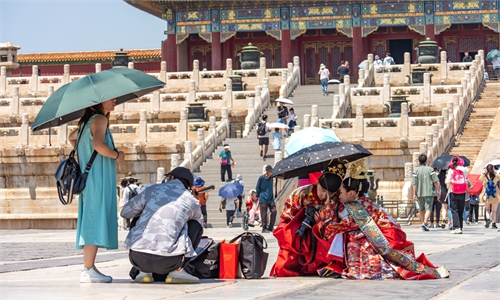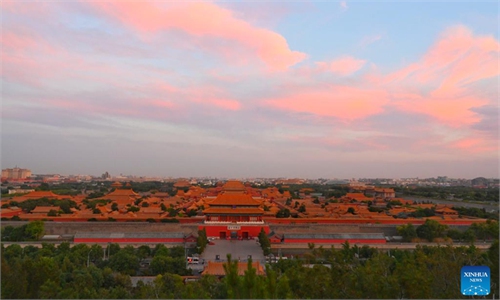ARTS / CULTURE & LEISURE
Program inspires young talents to inherit traditional cultures
A job carries on

The 16 participating students from the Bi-city Youth Cultural Leadership Programme visit the Palace Museum in Beijing. Photo: Courtesy of Hong Kong Palace Museum
Behind an inconspicuous red door deep in the Palace Museum in Beijing, relic restorers show 16 special young guests about the secrets of how the world's top technologies are used to preserve cultural relics from hundreds, even thousands of years ago.As part of the Bi-city Youth Cultural Leadership Programme hosted by Hong Kong, together with the Beijing Palace Musuem, students majoring in the humanities and arts with an interest in pursuing museum-related careers from top universities in both cities were invited to jointly conduct a 2-month-long deep city cultural tour.
The tour, running from July, is meant to offer participants the opportunity to discover the cultural connections between the two cities and their cultures.
"In the past, we have had many chances to conduct cultural exchanges between Hong Kong and the Chinese mainland. But most of time we remained within a single city such as Beijing or Dunhuang. But this time, we are planning something broader and bigger," Louis Ng, curator of the Hong Kong Palace Museum, told the Global Times.
"We had over one million visitors in the last year at the Hong Kong Palace Museum, which for us is quite a success. However, more talents need to be nurtured to invest in the development of museums, talents that can actually communicate with our visitors," said Ng, adding that the goal of the program is to expose more young people to the working mechanism of the museums "on the spot."
The Cultural Relics Protection Technology Research Institute, known as the Palace Museum Cultural Relics Hospital, was a highlight of the students' trip to Beijing. Experts exposed the students to a full range of scientific and technological experiences. The visiting students also gave their ideas and thoughts at an post-tour conference attended by Wang Xudong, curator of the Beijing Palace Museum, Lou Wei, deputy curator of the Beijing Palace Museum, and Hong Kong Palace Museum curator Ng.
Mutual learning
The Cultural Relics Protection Technology Research Institute, known as the Palace Museum Cultural Relics Hospital, was a highlight of the students' trip to Beijing. Experts exposed the students to a full range of scientific and technological experiences. The visiting students also shared their ideas and thoughts at an post-tour conference attended by Wang Xudong, curator of the Beijing Palace Museum, Lou Wei, deputy curator of the Beijing Palace Museum, and Hong Kong Palace Museum curator Ng.
"Hong Kong is a city known for its diversity, while Beijing is more famous for its profound traditional culture," said Gui Xianxian, a student from the Beijing Normal University and an intern at the Hong Kong Science Museum, while talking about her ideas about of the two cities.
Lu, another art history student from Hong Kong noted that the experience gained over the last eight weeks has widened his eyes to the "different possibilities in working for a cultural institute."
"It was a very valuable experience for me and made me think about what career I want to pursue in museums in the future," Lu added that his goal has always been to "work in museums."

Students from the Bi-city Youth Cultural Leadership Programme pose for photographs at the Palace Museum in Beijing. Photo: Courtesy of Hong Kong Palace Museum
Far from Beijing being their first stop, the group of 16 talented youths spent the first six weeks of the two-month course gaining hands-on experience, from exploring the West Kowloon Cultural District and participating in a series of seminars, lectures, and workshops, to share their experiences of Hong Kong's history and culture with scholars, experts and artists.The students' two-week trip to Beijing has included a tour of the UCCA, the city's leading contemporary art institution, and the Moonshot Academy, a 12-year school in China, being described as an "innovative school rooted in China and oriented to the world."
"In fact, this is the second phase of our plan," Ng said.
In the first phase, which ended in February 2023, a total of 95 students were invited to visit.
"We wanted to differentiate our tours from other educational tours as we wanted to keep the groups tight and small so that younger participants could learn more about our expertise as well as our fine traditional culture," said the curator.
Continuous cooperation
Cooperation in education is not only reflected in the cultivation of talents.
The Hong Kong Palace Museum looks forward to introducing Beijing's digital achievements in assisting the Hong Kong Palace Museum in the research in and preservation of cultural relics.
"The Palace Museum in Beijing has done a very good job in digitization. More than 100,000 cultural relics have been digitized and can be viewed online," Ng said.
In addition to education, the cooperation between Hong Kong and the Palace Museum in Beijing covers many fields. In October, a cultural relic preservation seminar will be held in Hong Kong with experts from home and abroad.
Since the opening of the Hong Kong Palace Museum in July 2022, successful cooperation between Beijing and Hong Kong has injected more possibilities in terms of future closer ties between the two museums.
In addition to the previous batches cultural relics exhibited in Hong Kong on loan from the Beijing Palace Museum, the Hong Kong Palace Museum curator told the Global Times that as of now, there are still at least 5,000 to 8,000 cultural relics on loan from Beijing waiting to be displayed in Hong Kong.
As the curator said, the Hong Kong side's goal is to present the culture of the Beijing Palace Museum to international tourists in a more creative and enriching way, "and it is expected to be realized through completely different themes and forms of expressions."
"Our two museums have a very clear goal, which is to expand our international influence, spread our excellent traditional culture, and let more overseas audiences understand our culture, so we will strengthen cooperation in the future and jointly spread the voice of China, which is an important part of our all-round cooperation with Beijing."



